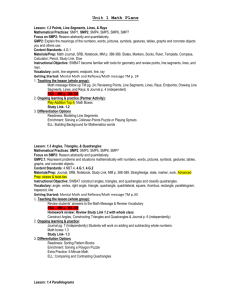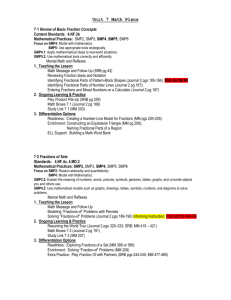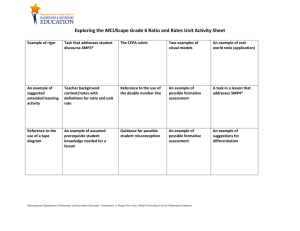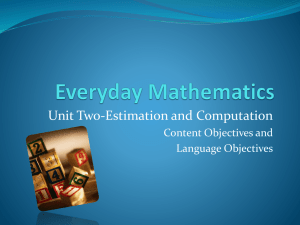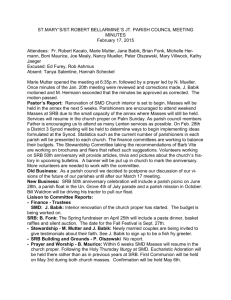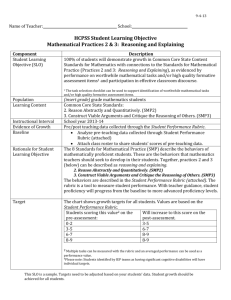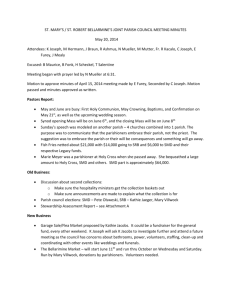Math Unit 1
advertisement
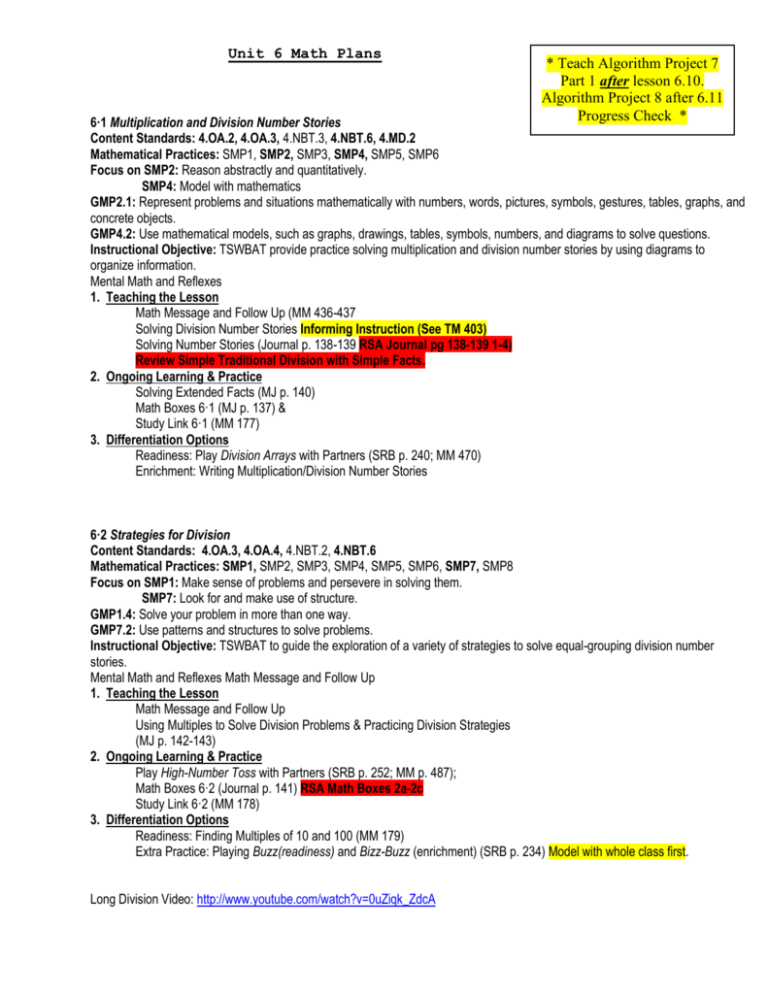
Unit 6 Math Plans * Teach Algorithm Project 7 Part 1 after lesson 6.10. Algorithm Project 8 after 6.11 Progress Check * 6·1 Multiplication and Division Number Stories Content Standards: 4.OA.2, 4.OA.3, 4.NBT.3, 4.NBT.6, 4.MD.2 Mathematical Practices: SMP1, SMP2, SMP3, SMP4, SMP5, SMP6 Focus on SMP2: Reason abstractly and quantitatively. SMP4: Model with mathematics GMP2.1: Represent problems and situations mathematically with numbers, words, pictures, symbols, gestures, tables, graphs, and concrete objects. GMP4.2: Use mathematical models, such as graphs, drawings, tables, symbols, numbers, and diagrams to solve questions. Instructional Objective: TSWBAT provide practice solving multiplication and division number stories by using diagrams to organize information. Mental Math and Reflexes 1. Teaching the Lesson Math Message and Follow Up (MM 436-437 Solving Division Number Stories Informing Instruction (See TM 403) Solving Number Stories (Journal p. 138-139 RSA Journal pg 138-139 1-4) Review Simple Traditional Division with Simple Facts. 2. Ongoing Learning & Practice Solving Extended Facts (MJ p. 140) Math Boxes 6·1 (MJ p. 137) & Study Link 6·1 (MM 177) 3. Differentiation Options Readiness: Play Division Arrays with Partners (SRB p. 240; MM 470) Enrichment: Writing Multiplication/Division Number Stories 6·2 Strategies for Division Content Standards: 4.OA.3, 4.OA.4, 4.NBT.2, 4.NBT.6 Mathematical Practices: SMP1, SMP2, SMP3, SMP4, SMP5, SMP6, SMP7, SMP8 Focus on SMP1: Make sense of problems and persevere in solving them. SMP7: Look for and make use of structure. GMP1.4: Solve your problem in more than one way. GMP7.2: Use patterns and structures to solve problems. Instructional Objective: TSWBAT to guide the exploration of a variety of strategies to solve equal-grouping division number stories. Mental Math and Reflexes Math Message and Follow Up 1. Teaching the Lesson Math Message and Follow Up Using Multiples to Solve Division Problems & Practicing Division Strategies (MJ p. 142-143) 2. Ongoing Learning & Practice Play High-Number Toss with Partners (SRB p. 252; MM p. 487); Math Boxes 6·2 (Journal p. 141) RSA Math Boxes 2a-2c Study Link 6·2 (MM 178) 3. Differentiation Options Readiness: Finding Multiples of 10 and 100 (MM 179) Extra Practice: Playing Buzz(readiness) and Bizz-Buzz (enrichment) (SRB p. 234) Model with whole class first. Long Division Video: http://www.youtube.com/watch?v=0uZiqk_ZdcA 6·3 The Partial-Quotients Division Algorithm, Part 1 Content Standards: 4.OA.3, 4.NBT.6, 4.MD.2 Mathematical Practices: SMP1, SMP2, SMP3, SMP4, SMP5, SMP6, SMP7, SMP8 Focus on SMP1: Make sense of problems and persevere in solving them. SMP7: Reason abstractly and quantitatively. GMP1.2: Make a plan for solving a problem. GMP2.1: Represent problems and situations mathematically with numbers, words, pictures, symbols, gestures, tables, graphs, and concrete objects. Instructional Objective: TSWBAT intro. & provide practice with a “low stress” division algorithm for 1-digit divisors. Mental Math and Reflexes 1. Teaching the Lesson Math Message and Follow Up Introducing the Partial-Quotients Algorithm (MM 403, 438) (Informing Instruction – TM416); Using the Partial-Quotients Algorithm (MJ p. 144-145) (RSA Journal pgs. 144-145 pr. 1,2,5) 2. Ongoing Learning & Practice Reviewing Place Value in Decimals (MJ p. 146); Math Boxes 6·3 (MJ p. 147) & Study Link 6·3 (MM 180) 3. Differentiation Options Readiness: Play Beat the Calculator (SRB p. 233; MM 461) Enrichment: Determining the Cost of Pens (MM 181) Extra Practice: Playing Division Dash with Partners (SRB 241; MM 471) ELL Support: Build Vocabulary 6·4 Expressing and Interpreting Remainders Content Standards: 4.OA.3, 4.OA.4, 4.NBT.6, 4.MD.2 Mathematical Practices: SMP1, SMP2, SMP3, SMP4, SMP6 Focus on SMP2: Reason abstractly and quantitatively. SMP4: Model with mathematics. GMP2.2: Explain the meaning of the numbers, words, pictures, symbols, gestures, tables, graphs, and concrete objects you and others use. GMP4.1: Apply mathematical ideas to real-world situations. Instructional Objective: TSWBAT Intro. the expression of remainders as fractions or decimals; & to provide practice interpreting remainders in division problems. Mental Math and Reflexes 1. Teaching the Lesson Math Message and Follow Up Expressing Remainders as Fractions or Decimals; Interpreting Remainders in Problem Contexts; Solving Division Problems and Interpreting Remainders (MJ p. 148-149) 2. Ongoing Learning & Practice Play Division Dash with Partners (SRB p. 241; MM 471); Math Boxes 6·4 (MJ p.150) RSA Math Boxes Problem 3 Study Link 6·4 (MM 182) 3. Differentiation Options Readiness: Exploring Remainders in Literature (MM 183) Enrichment: Solving a Multiples Number Story (MM 184) Extra Practice: 5-Minute Math 6·5 Rotations and Angles Content Standards: 4.MD.2, 4.MD.5a, 4.MD.5b Mathematical Practices: SMP1, SMP2, SMP3, SMP4, SMP5, SMP6 Focus on SMP1: Make sense of problems and persevere in solving them. SMP5: Use appropriate strategically. GMP1.6: Connect mathematical ideas and representations to one another. GMP5.2: Use mathematical tools correctly and efficiently. Instructional Objective: TSWBAT review rotations; & to guide students as they make & use a full-circle protractor. Mental Math and Reflexes 1. Teaching the Lesson Math Message and Follow Up Investigating Rotations and Degree Measures MJ p. 152) Informing Instruction TM 427; Forming Angles of Given Measures (MJ p. 152) Measuring Elapsed Time in Degrees (MJ p. 152-153) 2. Ongoing Learning & Practice Making a Bar Graph (Journal pg 154; SRB p. 301) RSA Journal pg 154; Solving Elapsed-Time Problems (MJ 154A-154B) Math Boxes 6·5 (MJ p. 151) Study Link 6·5 (MM 185) 3. Differentiation Options Readiness: Matching Alternate Time Displays (MM186-188) Enrichment: Measuring Elapsed Time in Degrees (Journal p. 152-153; MM 189) Extra Practice: Play Robot with Partners ELL Support: Building a Math Word Bank (Differentiation Handbook) 6·6 Using a Full-Circle Protractor Content Standards: 4.NBT.6, 4.MD.2, 4.MD.5a, 4.MD.5b, 4.MD.6, 4.MD.7 Mathematical Practices: SMP2, SMP3, SMP5, SMP6, SMP7, SMP8 Focus on SMP5: Use appropriate tools strategically. SMP7: Look for a make use of structure. GMP5.2: Use mathematical tools correctly and efficiently. GMP7.1: Find, extend, analyze and create patterns. Instructional Objective: TSWBAT provide practice using a full-circle protractor to measure and draw angles less then 360 degrees. Mental Math and Reflexes 1. Teaching the Lesson Math Message and Follow Up (SRB p. 92) Demonstrating Angles and Rotations; Using a Full-Circle Protractor (MJ p. 155; SRB p. 142; MM 439) Informing Instruction TM 434 Drawing an Angle RSA Exit Slip see TM 435 2. Ongoing Learning & Practice Play Division Dash with Partners (SRB p. 241; MM 471) Math Boxes 6·6 (Journal p.156) Study Link 6·6 (MM 190) 3. Differentiation Options Readiness: Making and Using a Waxed-Paper Protractor (MM 191) Enrichment: Playing Angle Add-Up (MM 439, 507-509) Extra Practice: Play Angle Tangle with Partners (SRB p. 230; MM 457) ELL Support: Building Background for Mathematics Words 6·7 The Half-Circle Protractor Content Standards: 4.MD.5a, 4.MD.5b, 4.MD.6, 4.MD.7 Mathematical Practices: SMP1, SMP2, SMP3, SMP4, SMP5, SMP6 Focus on SMP5: Use appropriate tools strategically. GMP5.2: Use mathematical tools correctly and efficiently. GMP5.3: Estimate and use what you know to check the answers you find using tools. Instructional Objective: TSWBAT guide students as they classify angles as a acute, right, obtuse, straight, and reflex; and to provide practice using a half-circle protractor to measure an draw angles. Mental Math and Reflexes RSA Mental Math and Reflexes 1. Teaching the Lesson Math Message and Follow Up (MJ p. 157) Introducing the Half-Circle Protractor; Measuring Angles with a Half-Circle Protractor (MJ p. 157) Informing Instruction TM 440 Drawing Angles with a Half-Circle Protractor (MJ p. 158) *Adding and Subtracting to Find Missing Angle Measures* 2. Ongoing Learning & Practice World Tour Option: Visiting Europe (MJ p. 171–173,180-181;SRB; MM 419-421) Math Boxes 6·7 (MJ p. 159) Study Link 6·7 (MM 192) 3. Differentiation Options Readiness: Modeling Angles (SRB p. 93) Enrichment: Measuring Angles in Triangles (MM 193) Exploring Angles in Literature (MM 388-389) ELL Support: Building Background for Mathematics Words (Differentiation Handbook) 6·8 Rectangular Coordinate Grids for Maps Content Standards: 4.OA.3, 4.MD.5a, 4.MD.5b, 4.MD.6, 4.MD.7 Mathematical Practices: SMP1, SMP2, SMP4, SMP5, SMP6, SMP8 Focus on SMP1: Make sense of problems and persevere in solving them. SMP8: Look for and express regularity in repeated reasoning. GMP1.4: Solve your problem in more than one way. GMP8.2: Use properties, rules, and shortcuts to solve problems. Instructional Objective: TSWBAT guide students in the use of letter-number pairs and ordered pairs of numbers to locate points on a grid; and to provide practice using map scale. Mental Math and Reflexes 1. Teaching the Lesson Math Message and Follow Up (Journal pg 162) Using Ordered Pairs to Locate Points on a Map (Journal pg 162) RSA Math Log or Exit Slip see TM 445 2. Ongoing Learning & Practice Play Angle Tangle with Partners (SRB pg 230; MM 457) Finding Real-Life Angle Measures Math Boxes 6·8 (Journal pg 160) Study Link 6·8 (MM 194) 3. Differentiation Options Readiness: Moving on a Coordinate Grid Enrichment: Play Grid Search with Partners (SRB pgs 250-251; MM 486) Extra Practice: Plotting and Naming Points on a Coordinate Grid (MM 440) 6·9 Global Coordinate Grid System Mathematical Practices: SMP1, SMP2, SMP3, SMP4, SMP6 Focus on SMP3: Construct viable arguments and critique the reasoning of others. SMP4: Model with mathematics. GMP3.3: Work to make sense of others’ mathematical thinking. GMP4.1: Apply mathematical ideas to real-world situations. Instructional Objective: TSWBAT introduce latitude and longitude; to provide practice finding the latitude and longitude of places on a globe and a map; and to identify places given the latitude and longitude. Mental Math and Reflexes 1. Teaching the Lesson Math Message and Follow Up Studying a World Globe (SRB pgs 272-273); Introducing the System for Locating Places on the Globe; Locating Places on a World Map Locating Places on Regional Maps (Journal pg 164; SRB pgs 282-293) Informing Instruction see TM 453 2. Ongoing Learning & Practice Play Over and Up Squares with Partners (SRB pg 257; MM 494) Math Boxes 6·9 (Journal pg 165) RSA Math Boxes Problem 2 Study Link 6·9 (MM 195) 3. Differentiation Options Enrichment: Using Time to Determine Longitude (MM 388-389) Extra Practice: Locating Places with Latitude and Longitude (MM 196) 6·10 The Partial-Quotients Division Algorithm, Part 2 Content Standards: 4.OA.3, 4.NBT.6 Mathematical Practices: SMP1, SMP2, SMP4, SMP5, SMP6, SMP7, SMP8 Focus on SMP4: Model with mathematics. SMP7: Look for and make use of structure. GMP4.2: Use mathematical models such as graphs, drawings, tables, symbols, numbers, and diagrams to solve problems. GMP7.2: Use patterns and structures to solve problems. Instructional Objective: TSWBAT provide practice with “low-stress” division algorithm for 2-digit divisors. Mental Math and Reflexes 1. Teaching the Lesson Math Message and Follow Up Introducing the Partial-Quotients Algorithm with 2-Digit Divisors (MM 438) Using Partial-Quotients Algorithm w/ 2-Digit Divisors (Journal pg 166-167; MM 438) RSA Journal pg 166 problems 1-2 2. Ongoing Learning & Practice Taking a 50-Facts Test (MM 413-414, 416) Math Boxes 6·10 (Math Journal page 168) Study Link 6·10 (Math Masters page 107) 3. Differentiation Options Readiness: Play Division Dash with Partners (SRB 241; MM 471) Enrichment: Performing a “Magic Trick” (MM 198) Algorithm Project 7: U.S. Traditional Long Division, Part 1 (pg. A31) Materials/Prep: Math Journal 1 or 2, pp. 25P-27P; Student Reference Book, p. 24E & 24H Instructional Objective: SWBAT introduce U.S. traditional long division Mathematical Practices: SMP1, SMP2, SMP3, SMP4, SMP5, SMP6, SMP8 Content Standards: 4.NBT.6 Doing the Project: Solve a Division Problem – Math Journal 1 or 2 pg. 25P (whole group) Introducing Long Division (whole group) Solving Long Division Problems with One-Digit Divisors – Math Journal 1 or 2 pgs. 25P-27P; SRB pgs. 24E-24H (partner activity) Extending the Project: Writing and Solving Division Number Stories – Student Reference Book pgs. 24E – 24H (partner activity) Solving Division Problems – Online Additional Practice pgs. 27A-27C; SRB pgs. 22-24 & 24E-24H (independent activity) 6·11 Progress Check 6 Math Message & Assessment Handbook page 179 1. Assessing Progress Oral and Slate Assessments; Written Assessment ~ Assessment Handbook pages 180 – 182 Open Response ~ Assessment Handbook page 183 Midyear Assessment ~ Assessment Handbook pages 228 - 233 2. Building Background for Unit 5 Math Boxes 6·11 (Math Journal page 169) Study Link 6·11: Unit 7 Family Letter ~ Math Masters pages 199 – 202 Algorithm Project 8: U.S. Traditional Long Division, Part 2 (pg. A37) Materials/Prep: Math Journal 1 or 2, pp. 28P-30P; Student Reference Book, p. 24E & 24J & 40D-40F Instructional Objective: SWBAT extend U.S. tradition long division with single-digit divisors to four- and five-digit dividends and dividends in dollars-and-cents notations. Mathematical Practices: SMP1, SMP2, SMP3, SMP4, SMP5, SMP6, SMP8 Content Standards: 4.NBT.6 Doing the Project: Solve a Division Problem – Math Journal 1 or 2 pg. 28P (whole group) Extending Long Division to Larger Dividends (whole group) Solving Long Division Problems – Math Journal 1 or 2 pgs. 28P-29P; SRB pgs. 24E-24J (partner activity) Extending Long Division to Dollars – and – Cents notation Extending the Project: Writing and Solving Division Number Stories – Student Reference Book pgs. 24E – 24J & 40D – 40F (partner activity) Solving Division Problems – Online Additional Practice pgs. 30A-30C; SRB pgs. 22-24 & 24E-24J & 40D - 40F (independent activity)

